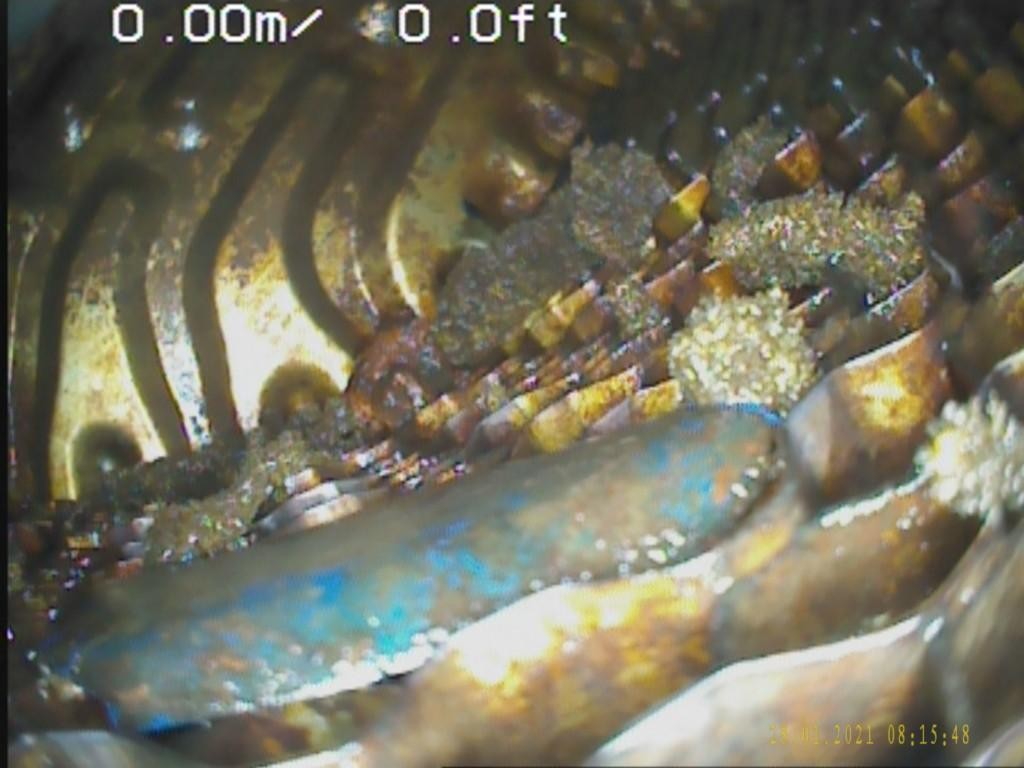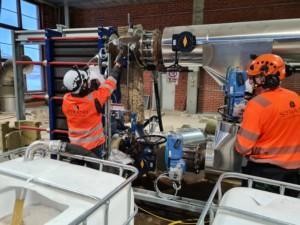What affects the performance of a heat exchanger?
 The performance of your heat exchangers is directly affected by the fouling inside of the heat exchangers. Fouling occurs as liquids flow through a heat exchanger. Solids and debris inside the closed-loop will collect and build up on the plates inside, restricting the flow.
The performance of your heat exchangers is directly affected by the fouling inside of the heat exchangers. Fouling occurs as liquids flow through a heat exchanger. Solids and debris inside the closed-loop will collect and build up on the plates inside, restricting the flow.
As the flow becomes more restricted, the heat exchanger will gradually lose its efficiency and reduce the heat exchange. Besides limiting the flow, the build-up of deposits on heat-transfer surfaces also reduces the heat exchanger’s capacity to transfer heat.
The degraded performance of your heat exchanger leads to an increase in operating and energy costs. As the system is under increasing strain, the following could occur.
- A general decrease in performance
- Seemingly random deviations from the operating temperature or operation requirements.
- Internal and external leakage
- Disturbance in processes.
- Increased capacity needs
- Unusually high energy consumption.
How to prevent heat exchanger fouling
Fouling occurs naturally over time, and there are no proven ways to eliminate it. But rather than replacing faulty equipment or parts, there are more cost-efficient ways to make sure your heat exchangers keep running at optimal efficiency throughout their lifecycle.
Cleaning heat exchangers
Regular cleaning of heat exchangers is the most effective way to maintain your heat exchangers’ performance and lifespan. It guarantees that equipment will remain in operational condition and reduces the risk of emergency repairs. It removes the built-up debris from the heat exchange surfaces and reduces the effects of fouling significantly.
Why should heat exchangers be cleaned?
Fouling has a significant impact on the overall performance of your process efficiency. If you fail to clean your heat exchangers regularly, you will run the risk of:
- Increased maintenance to remove heavy fouling deposits
- Replacement of broken equipment and parts.
- An increase in Co2 production
- Downtime and Shutdowns
The overall cost of downtime is influenced by:
- The duration of the downtime
- Time and date
- The impact on other internal departments
- 3rd parties that rely on your production
- The industry
Study shows that 98% of organizations suffer from $100,000 in costs and lost profit from 1 hour of downtime. On average, manufacturers and producers suffer from 800 hours of unplanned downtime annually.
Down the line, these risks will eat away at your operational efficiency and profit margins. The cost of cleaning a heat exchanger is minimal compared to the costs associated with production downtime or equipment replacement.
How to clean a heat exchanger
Depending on the severity of the fouling, there’s several ways to clean a heat exchanger.
On-site VS Off-site cleaning
Off-site cleaning is utilized whenever a heat exchanger has suffered severe fouling and requires complete submersion in cleaning agents.
The heat exchanger is taken to an off-site facility and lowered in a bath filled with cleaning liquid. The heat exchanger is mechanically rotated and exposed to pressurized jets of cleaning fluid. Any fouling and debris is agitated and loosened from the outer shell, while cleaning liquid is also pumped through the inner system.
The benefits of off-site cleaning
- No risks for own maintenance personnel or damage due to improper handling.
- No 1st party waste disposal is required.
- Easy to inspect the equipment when removed from the production line.
- Suits most equipment, limited by weight and size.

Off-site cleaning requires the heat exchanger to be removed from the production line. This involves a production shutdown if no failovers are present.
While off-site cleaning is usually performed at dedicated facilities, cleaning specialists like our partner RecondConcept perform submersion cleaning on-site with their unique cleaning equipment.
On-site cleaning is performed at the production facility, with the equipment remaining in place and mostly connected to the production line. The heat exchanger does not have to be disassembled. Instead, it’s cleaned with special “Clean-in-Place” (CIP) cleaning equipment. The cleaning method usually consists of chemical or mechanical cleaning or a combination of both.
The benefits of on-site cleaning
- Significantly faster cleaning process
- Less labor required
- No, or very little downtime
- Cheaper compared to off-site cleaning.
On-site cleaning is most suitable for heat exchangers that have not suffered from severe fouling. Using several chemical solutions, the cleaning technicians will loosen any organic and fouling debris and flush them out of the system. Any chemicals used will be carefully collected and disposed of in an ecologically responsible manner.
Types of chemicals used
Depending on the heat exchanger type and application use, cleaning technicians usually rely on the following types of chemicals:
- Alkaline agents like ammonia and caustic soda. These are used to remove organic materials like grease and fat.
- Oxidants like sodium nitrate and bromate, and potassium permanganate. These are used for “passivation”, which creates a protective layer against corrosion.
- Hydrocarbonic solvents are used to dissolve built-up deposits. These acidic chemicals are regulated and will be carefully selected and processed based on the cleaning needs.
Your cleaning technicians will have taken your processes into account as they make their cleaning method recommendations. You can read more about the commonly used CIP chemicals here.
Hydro jetting
Hydro jetting works by using a high-pressure stream of water to clean the surfaces of the exchanger. The water is typically supplied by a pump, and it is directed through a hose to the exchanger. The high pressure of the water can remove any debris or fouling that may have built up on the surfaces of the exchanger. This can help to improve the heat transfer efficiency of the exchanger and increase its lifespan.
Hydro jetting can also be used for cleaning other types of industrial equipment, such as reactors, tanks, and pipes. It is a safe and effective way to remove build-ups of debris and fouling without damaging the equipment. Hydro jetting is often used in combination with other cleaning methods, such as chemical cleaning, to provide a complete cleaning solution.
When should a heat exchanger be cleaned?
With periodic cleaning, your heat exchangers will keep operating at peak efficiency. But determining which heat exchanger to clean and when, is a challenge in its own right. You must balance the benefits with the productivity loss from downtime.
So how do you determine which heat exchanger requires cleaning?
Heat Exchanger Fouling factors
Three key factors influence the frequency and severity of fouling.
Fluid Temperature
Minerals like salt increase their deposits on heat transfer surfaces at higher water temperatures. Higher water temperature also leads to more favorable conditions for biological growth.
Flow Rate
Fouling tends to increase at lower flow rates. At higher flow rates, the fluid velocity will help remove deposits at the expense of heat exchange efficiency.
Fluid Type
The chemical composition of a fluid directly affects the type of build-up, ranging from fats, proteins, minerals, and sugars.
Cleaning frequency
Reactive maintenance can be performed once an underperforming heat exchanger is discovered. Typical signs of underperformance are:
- Incorrect operating temperatures
- Reduced flow rates
- Higher power requirements from circulatory pumps
- Overall reduced exchange performance
Reactive maintenance aims to solve an already occurred problem, meaning that at this point, it already has a significant effect on your operating efficiency and cost.
By relying on historical maintenance data, a preventive maintenance schedule can be configured. This schedule anticipates when a heat exchanger suffers from performance issues and plans maintenance and cleaning accordingly. This works well in standardized operating environments but may lead to over-maintenance and higher maintenance costs.
A more modern and cost-efficient solution is predictive maintenance.
Predictive maintenance allows you to detect whenever equipment operates outside normal parameters. This will enable you to trigger maintenance to eliminate the loss in efficiency before it takes place. It is also used to confirm successful cleaning operations.
By shifting to predictive maintenance, your processes become more flexible and dynamic as it self-optimizes your cleaning frequency to your fluids and equipment.


HeatHamster offers energy and profit savings as a service
HeatHamster is the only solution in the world that combines cloud analysis of heat exchanger performance data with predictive maintenance signals and automated cleaning. By implementing HeatHamster, the entire process of monitoring, diagnosing, and cleaning is taken care of. Your equipment will consistently operate at peak efficiency, at a fraction of the price of alternative maintenance methods. Leaving you with energy and profit savings in return.
Let's work together!

IndMeas Oy Ab, Vaisalantie 6, FI-02130 Espoo, Finland
© 2021 IndMeas Oy Ab. All rights reserved.

